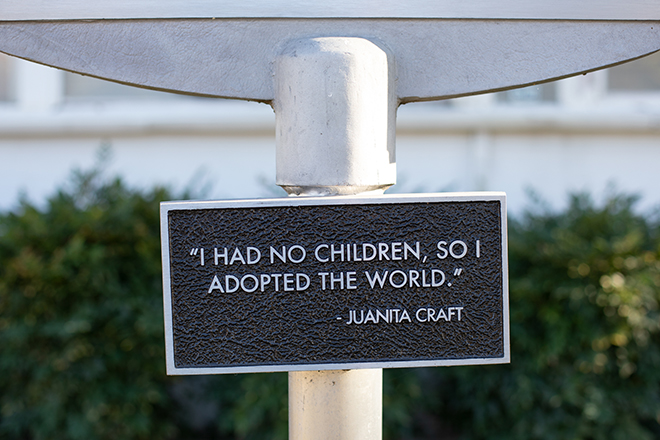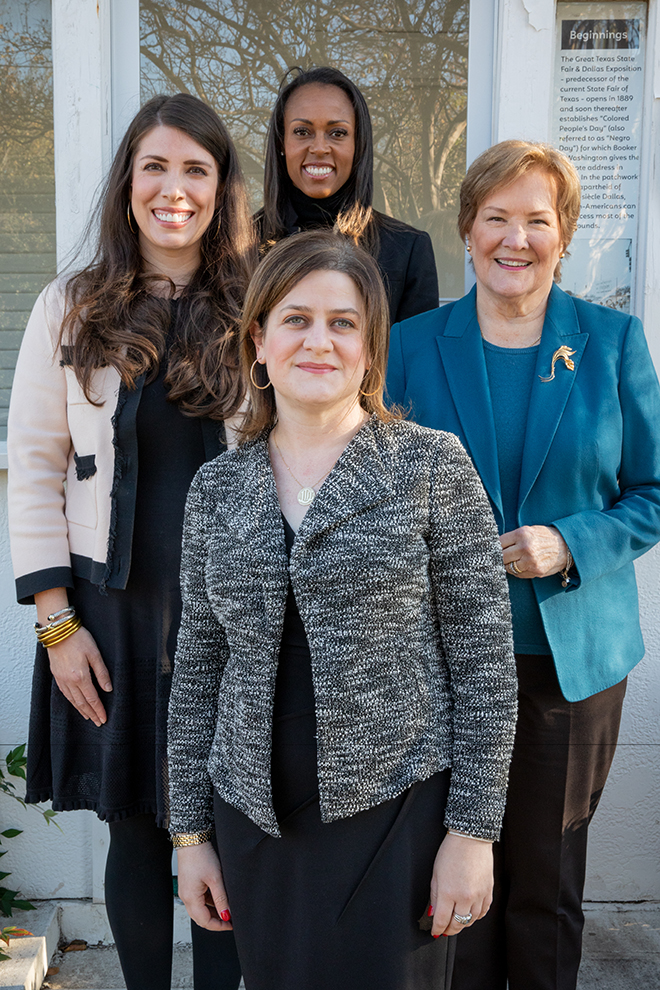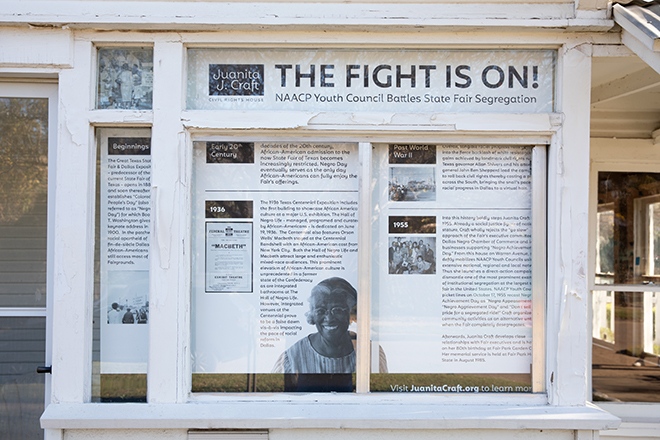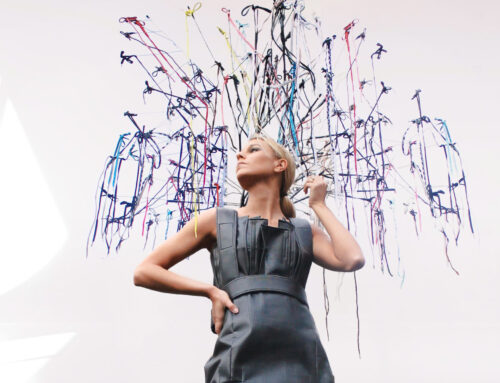
Photography by Owen Jones
A modern Dallas was being shaped.
Two years after the 19th Amendment was approved, 10 Dallas women, mostly mothers, decided to form the 22nd Junior League in the United States in 1922. That decision kickstarted 100 years of philanthropy, focusing on issues from education to domestic violence. From buildings and parks to the most impactful philanthropy, Junior League women have been instrumental in molding Dallas.
“We have shaped the impact that women can have in all parts of the functioning of our community and our city. The League trains volunteers, but we train leaders, too,” says League president-elect Christa Sanford.
Genesis Women’s Shelter CEO Jan Langbein developed her passion — fighting domestic violence — as a League member. Our Friends Place, an organization dedicated to assisting abused, impoverished and homeless young women, was started by League member Susybelle Gosslee. Artist and former Christies vice president Carolyn Burns Foxworth served on the Dallas Museum of Art board and was appointed by Gov. Bill Clements to the Texas State Fine Arts commission. A League president in 1967, Sally Freeman McKenzie was involved in national political campaigns beginning with Dwight D. Eisenhower’s presidential run in 1956. She was a delegate to the United Nations Commission on the Status of Women, served on the board of more than 20 organizations in Dallas and held several C-level corporate posts. That’s only four women out of thousands who have been League members.
“I don’t see the history of the League as building a grand monument one year, and then 10 years later doing something less magnificent. It is just a very steady river of assistance to the whole city of Dallas,” says sustaining member Margo Goodwin.

Joining the League serves as launchpad to volunteering for women ages 22 to 45. Volunteers are either placed in in-league positions where they focus on organizational matters or embedded in outside agencies as community volunteers. Both positions have a yearly hours requirement of donated time. Members are trained on time management, how to operate a board, fundraising, underwriting and more. Once a member is older than 45, she’s no longer required to fulfill the hours requirement. With a membership of 4,000, the League provides funding and volunteers to about 40 organizations.
“We like to think of it as sort of a one-two punch. We’re providing funding, but we’re doubling, tripling our impact by sending volunteers. We’re certainly seeing that now during the pandemic,” says current president Elizabeth Dacus. “The agencies are really coming back to us and saying ‘we feel how much you help us’.”
The organization pivoted a lot of its operations to virtual this year. League members are still able to work with English-learning groups and help with financial training for those who don’t have resources. Volunteers pick up supplies to prep school projects and take them to teachers. “It’s a whole new level of stress that we’re seeing with teachers trying to figure out how to do things socially distant, how to have classes online, plus in person, and so anything some of our volunteers can do helps,” Dacus says. The League’s innovative teaching program makes small grants to Dallas ISD Teachers, and the League raises money for applicants requesting up to $2,500 for their classrooms.
The League’s innovative teaching program makes small grants to Dallas ISD Teachers, and the League raises money for applicants requesting up to $2,500 for their classrooms.
“It’s not a huge amount of money, but it’s an opportunity to do some really cool things in their classrooms that they never would have been able to do, everything from technology to kids learning more about architecture to sustainable gardening,” Sanford says.
Typically, the League hosts an in-person awards ceremony gifting the grants. The virtual event this year awarded $85,000 to 40 DISD educators.
“Teachers come, and to see how excited they are!” Sanford says. “That money’s not going into their pockets, it is going into the minds of these kids, and how ecstatic they are to get this funding so that they can help their kiddos in their classrooms take their education one step further.”

Clockwise from center: Christa Sanford, Margo Goodwin, Elizabeth Dacus and Andrea Cheek.
Co-centennial chair Andrea Cheek arrived in Dallas not knowing many people or much about the city. A family friend suggested she join the League.
“I was really looking to meet like-minded women who enjoyed giving back to the community. Now I’ve been involved for 11 years, and I love it. And it really has made Dallas feel like home for me,” Cheek says.
Cheek and Goodwin, a member since 1977, are leading the efforts to restore the Juanita Craft House in South Dallas.
In 2016, a committee of 35 past League presidents was formed to help select a special centennial project for League members. Rather than selecting an organization they were already involved with, Cheek and Goodwin started talking with people throughout Dallas in hopes of finding the perfect project. Restoring the Juanita Craft house was suggested. The League vote selecting the project was unanimous.
Craft was a Dallas civil rights activist who organized more than 180 branches of the NAACP. She was the first Black woman in Dallas to vote in a public election, and she helped integrate Dallas ISD and the University of Texas Law School. Martin Luther King Jr. and President Lyndon B. Johnson both visited her Warren Street home in Wheatley Place Historic District.
“We looked into it, and the more we knew, the more it was obvious that it was the perfect choice. It will be around for a long time. Our members were very excited about it,” Goodwin says.
The home, which was flooded and severely damaged, will be renovated and restored by 2022. The League also is investing in an education program with DISD that will focus on Craft’s legacy.
“She was a self-trained volunteer, and what she accomplished is just a testament to what one woman can do when she puts her mind to it. It really resonated with all Junior League members,” Goodwin says.
In preparation for the group’s centennial celebration, League members began archiving and documenting a full list of League members who have founded agencies, served as public officials and lead public service initiatives.
“Thinking back 100 years ago, there were a few families that were involved in key efforts,” Sanford says. “But now, just the scope and breadth of the people who are involved with the Junior League, and even beyond the Junior League, who are really taking an interest in serving has really been incredible to see.

Junior League is entering the next 100 years in a post-COVID world. The past year drew attention to issues such as accessible health care, domestic violence, access to quality education and financial training that can pull people out of poverty. Arts organizations throughout Dallas lost more than $68 million in revenue during the first three quarters of 2020.
There is no shortage of issues for League members to tackle in coming years.
Sanford and the board hope to hit ground running in 2021.
“The centennial year, I don’t see it as the culmination of 100 years. It is truly the beginning of our next hundred years,” Sanford says. “We’re really thinking as a board about where is the League going to be for the next hundred years.”
The most important thing, Goodwin says, is to use your voice when you have something to say.
“The time to say it is when you’re thinking about it,” Goodwin says. “I think for all the years of the League from 1922 forward, I don’t know how long it took women to get to the point where we are now, where we realized that our voice matters, that we have the power and the intelligence to make a difference.”






